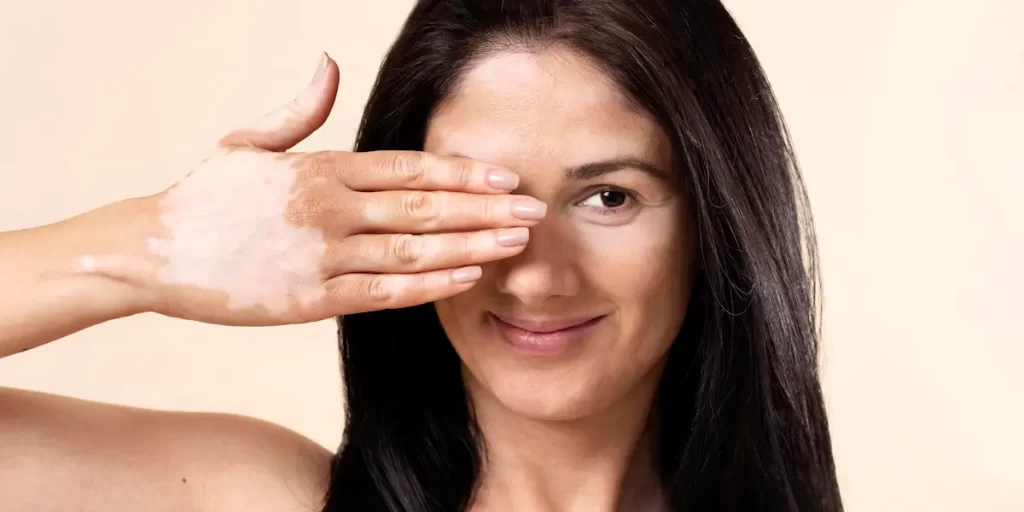Living with vitiligo can leave many feeling confused and frustrated. Vitiligo is a skin condition that causes white patches due to loss of skin pigment. This blog will explain its causes, treatments, and common myths to help you understand it better.
Thank you for reading this post, don't forget to subscribe!Keep reading—there’s hope and support ahead!
Key Takeaways
- Vitiligo causes white patches due to pigment loss and affects 0.5% to 2% of the world’s population, with most cases starting before age 30.
- It is an autoimmune condition where the immune system attacks melanocytes, often linked to genetics or triggers like stress and sunburns.
- Treatment options include phototherapy (UVB light), topical creams (corticosteroids, ruxolitinib), and emerging therapies like JAK inhibitors and afamelanotide.
- Emotional impacts are high, including social stigma and anxiety; support groups, counseling, and coping tools can help improve mental well-being.
- Vitiligo is not contagious, affects all skin types equally, and myths about its spread or risk based on race need debunking through education.
Understanding Vitiligo
Vitiligo causes white patches to form on the skin due to loss of pigment. It can affect anyone, regardless of age or skin tone.
What is Vitiligo?
Vitiligo is a skin condition that causes loss of color in patches. It happens because melanocytes, the cells that produce pigment, are destroyed or stop working. This leads to white patches on the skin, which can show up anywhere on the body.
The condition affects people of all ages and skin tones. Around 0.5% to 1% of the world’s population has vitiligo. It does not discriminate by gender or ethnicity and often starts before age 30.
Vitiligo shows how diverse human skin can be—beyond just its appearance.
How Common is Vitiligo?
Around 0.5% to 2% of the global population has vitiligo. This means over 50 million people worldwide experience this skin condition. In the UK, about 500,000 individuals live with it.
Studies show women report symptoms more often—68% of survey respondents were female.
It affects all skin colors and types but may be more noticeable on darker skin tones due to its depigmentation effects. Both children and adults can develop it, though most cases start before age 30.
Generalized vitiligo is the most common form, where white patches appear across multiple body areas.

Causes of Vitiligo
Vitiligo happens when the immune system attacks pigment cells. It can also run in families, linking it to genetic changes.
Genetic Factors
Changes in certain genes play a role in vitiligo. Over 30 genes are linked to an increased risk of this skin condition. Around 7% of people with a family history of vitiligo may develop it themselves, showing its hereditary nature.
A person with these genetic traits is more likely to have other autoimmune diseases like thyroid disease or alopecia areata. Studies suggest about 15% to 25% of individuals with vitiligo also share another autoimmune condition.
This overlap shows how the immune system and genetics can work together in triggering depigmentation disorders.
Autoimmune Responses
Genetics play a role, but the immune system’s mistakes add another layer. Vitiligo is widely regarded as an autoimmune disease. The immune system attacks melanocytes—cells that give skin its color—thinking they’re harmful.
This leads to white patches of depigmented skin on different parts of the body. Some people with this condition also face related issues like thyroid disease, rheumatoid arthritis, or type 1 diabetes.
Triggers can worsen these attacks on melanocytes. Sunburns or stress may spark flare-ups in many cases. Environmental factors, such as exposure to toxic chemicals and ultraviolet radiation, might harm melanocytes too.
Researchers continue looking into how exactly these triggers interact with the body and what causes certain people to be more prone than others.

Symptoms and Diagnosis
White patches on the skin are often the first sign of vitiligo. Doctors may use tools like a Wood’s lamp or blood tests to confirm it.
Identifying Symptoms
Small white macules or patches may first appear on the hands, forearms, feet, and face. These areas are often less than 1 cm in size at the start. Over time, they can grow larger and affect other regions like mucous membranes (mouth, nose), genitals, or even hair.
Itching might occur before these patches form. Commonly affected spots include fingers, toes, lips, and around the eyes. Skin color loss isn’t painful but is noticeable—especially on darker skin types.
Early signs should prompt a check with a health professional for proper diagnosis of this skin condition.
Diagnosis Processes
Identifying symptoms is key, but diagnosing vitiligo needs a closer look. A doctor uses several tools and steps to confirm this skin condition.
- Visual Examination
Doctors check white patches on the skin. They look for changes in color or patterns of skin pigmentation. - Medical History
The doctor asks about your family history of vitiligo or autoimmune diseases like thyroid disease or alopecia areata. They may also ask about stress levels, injuries, or chemical exposure. - Woods Lamp Test
A Woods lamp emits ultraviolet a light to highlight depigmented areas clearly. This helps spot early signs not visible to the naked eye. - Skin Biopsy
In rare cases, doctors take a small piece of skin for lab testing. It allows them to rule out other conditions like fungal infections or chemical leukoderma. - Blood Tests
Blood tests help detect related autoimmune conditions such as overactive thyroid gland issues or adrenocortical insufficiency. - Eye Exam
Some doctors check the irises and retinas for damage caused by vitiligo-related pigment loss. - Other Tests for Similar Conditions
They may rule out albinism, pityriasis alba, or tinea versicolor, which can mimic symptoms of vitiligo.
These steps help ensure an accurate diagnosis and guide effective treatments like ruxolitinib cream or UVB phototherapy later on.

Current Treatments for Vitiligo
Treatment for vitiligo focuses on restoring skin color or slowing pigment loss. Options vary and may depend on the type of vitiligo and its severity.
Phototherapy
Phototherapy uses narrow-band ultraviolet B (UVB) light to treat vitiligo. It helps restore skin pigmentation by stimulating melanin production in depigmented areas. Treatments usually involve two or three sessions per week, making it a regular routine for many patients.
Combining UVB therapy with JAK inhibitors like tofacitinib or ruxolitinib has shown promising results. This pairing can boost repigmentation, especially in stubborn patches of white skin.
Light boxes are often used during the sessions for precise exposure while reducing risks like scarring or burns.
Topical Treatments
Topical medications help manage symptoms of vitiligo. Corticosteroids reduce inflammation and may restore skin pigmentation over time. Calcineurin inhibitors, like tacrolimus, target the immune system and work well on sensitive areas such as the face.
Vitamin D analogues improve pigmentation by affecting melanin production in the skin.
New treatments show promise too. JAK inhibitors, like ruxolitinib cream, can repigment white patches effectively. Ruxolitinib is approved for use on facial and body areas affected by this condition.
These options aim to boost results when combined with other therapies, such as light therapy or depigmentation treatments.
Emerging Treatment Options
Advances in vitiligo research have introduced new and promising treatments. JAK inhibitors, like tofacitinib and ruxolitinib, show positive results for skin repigmentation. These drugs work by targeting immune system pathways that cause depigmentation.
Early studies suggest these treatments improve outcomes for facial vitiligo specifically.
Afamelanotide, a medication designed to boost skin pigmentation, is also gaining attention. It helps stimulate melanin production—especially when used with UVB light therapy. Biologics are another option being explored to manage autoimmune responses linked to this skin disorder.
These emerging options bring hope for improved care and better results over time.
Psychosocial Impacts of Vitiligo
Living with vitiligo can bring emotional hurdles and social struggles. People may feel isolated or face unfair treatment due to their skin condition.
Social and Emotional Challenges
People with vitiligo often face social stigma and isolation. Cultural views on skin disorders can harm self-esteem, especially in people with darker skin tones. Many individuals report feeling judged or misunderstood because of their white patches or skin color loss.
This emotional burden can lead to depression and anxiety. Daily interactions might trigger psychological distress due to unwanted attention or questions. Personal stories reveal struggles tied to self-image and society’s reactions.
Understanding these challenges helps address the needs of those affected—moving toward better support and coping mechanisms for a healthier mindset.
Support and Coping Mechanisms
Support is vital for managing the emotional and social effects of vitiligo. Building confidence and addressing challenges can improve mental well-being.
- Join organizations like Vitiligo Support International or the Global Vitiligo Foundation. They provide resources, connect patients, and offer expert guidance.
- Seek counseling to handle low self-esteem or psychological distress caused by social stigma. Cognitive-behavioral therapy can help change negative thoughts and improve coping skills.
- Use cosmetic tools like makeup or tattoos to camouflage white patches if desired. Permanent makeup options can restore skin color loss in small areas.
- Attend local support groups or online communities to share experiences with others who understand your journey. This creates a sense of belonging and reduces loneliness.
- Talk openly with trusted friends, family, or caregivers about your feelings. Honest communication builds understanding and strengthens relationships.
- Learn stress management techniques such as yoga, deep breathing, or meditation to reduce anxiety—stress may trigger symptoms in some cases.
- Focus on activities that enhance self-worth, like hobbies or volunteering, which shift attention away from the condition.
Debunking Common Myths
People often hold wrong ideas about vitiligo, leading to fear or confusion. Clearing these myths helps spread helpful and true information.
Myth: Vitiligo is Contagious
Vitiligo cannot spread from one person to another. It is a medical condition caused by the immune system attacking pigment-producing cells or other factors like genetics. Physical contact, sharing items, or close interaction does not transmit vitiligo.
There is also no connection between vitiligo and personal hygiene. This autoimmune disease affects everyone equally—regardless of race, skin tone, or lifestyle habits. Moving forward, let’s address another myth: who it can affect based on skin type….
Myth: Only Affects Certain Skin Types
It’s a common mistake to think vitiligo only impacts certain skin types. This condition affects people of all races, genders, and ethnicities equally. Its visibility may seem higher on darker skin due to the contrast between depigmented patches and natural pigmentation.
Around 50% of cases develop before age 20. These white patches can appear anywhere on the body, including mucous membranes or even hair. Skin color alone doesn’t determine risk for this autoimmune disorder.
Genetics and immune system responses play a bigger role than ethnicity or tone.
Conclusion
Vitiligo is more than just a skin condition. It affects the body, mind, and emotions. While there’s no cure yet, treatments like light therapy and topical creams offer hope. Education can help break myths and reduce stigma.
Support groups remind people they are not alone in their journey.
References
- https://www.health.harvard.edu/blog/vitiligo-more-than-skin-deep-2019092617885 (2019-09-26)
- https://pubmed.ncbi.nlm.nih.gov/20015281/
- https://medlineplus.gov/genetics/condition/vitiligo/ (2022-02-24)
- https://my.clevelandclinic.org/health/diseases/12419-vitiligo
- https://www.mayoclinic.org/diseases-conditions/vitiligo/diagnosis-treatment/drc-20355916
- https://jamanetwork.com/journals/jamadermatology/fullarticle/2612724
- https://pubmed.ncbi.nlm.nih.gov/28619557/
- https://pmc.ncbi.nlm.nih.gov/articles/PMC5986114/
